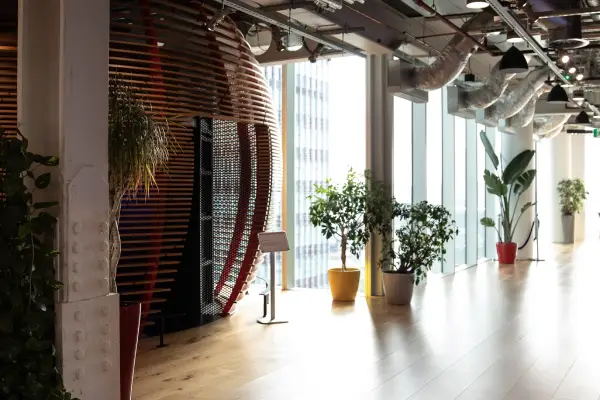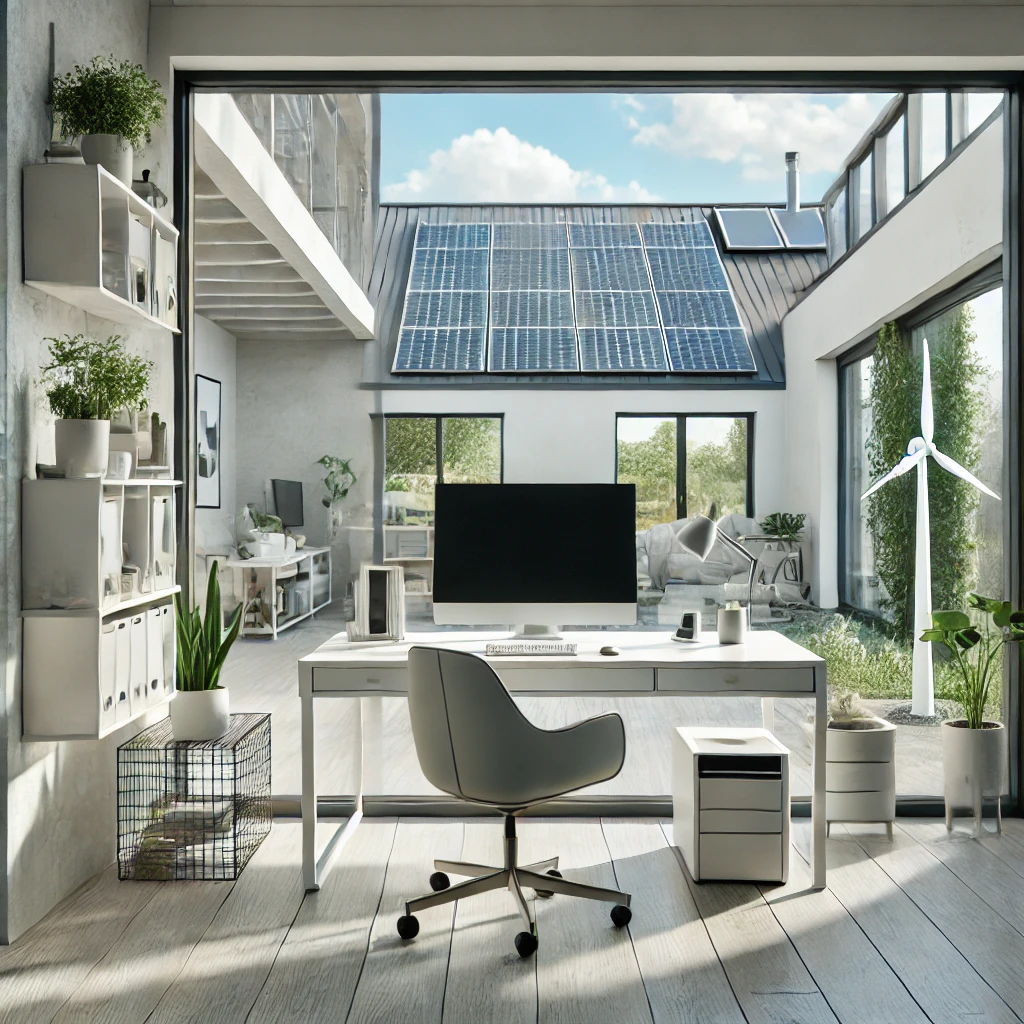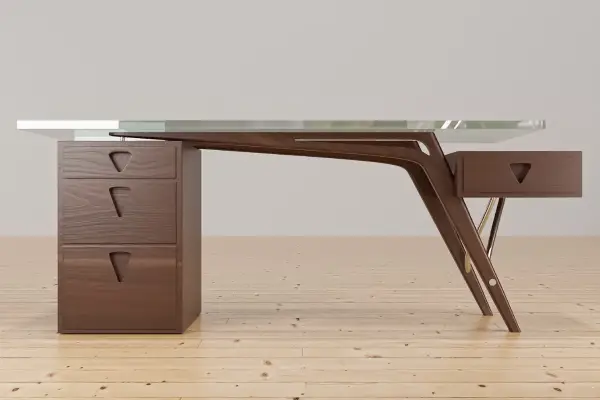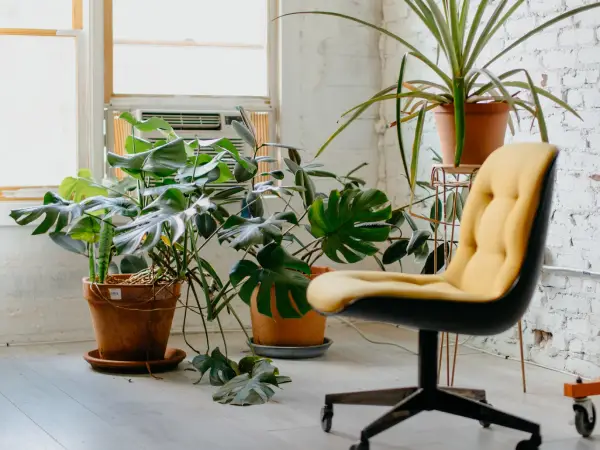Imagine walking into your office each morning and feeling an immediate sense of calm and focus. Your desk is clear, your essentials are within easy reach, and there’s a sense of order that seems to whisper, “You’ve got this.” Sounds like a dream, right? For many of us, the reality is quite the opposite. Desks piled high with papers, tangled cords, and an inbox that’s a ticking time bomb of unread emails. The clutter not only creates chaos but also drains our energy and productivity.
Enter minimalist organization – a refreshing approach that’s more than just a trend. It’s a lifestyle shift that prioritizes simplicity and efficiency, allowing you to focus on what truly matters. Minimalism isn’t about living with nothing; it’s about living with enough. It’s about making space – both physical and mental – for what’s important, and eliminating the distractions that hinder our productivity and well-being.
In this article, we’ll dive into practical techniques to transform your office into a minimalist haven. From decluttering your workspace and organizing essentials to creating an efficient layout and maintaining your newfound order, we’ve got you covered. Get ready to discover how a minimalist office can not only boost your efficiency but also bring a sense of peace and clarity to your workday.
So, if you’re tired of the clutter and ready for a change, keep reading. It’s time to simplify your office and unlock your maximum efficiency.
Understanding Minimalism in the Office
Minimalism is more than just an aesthetic choice; it’s a mindset and a lifestyle that can transform the way you work. When applied to the office, minimalism isn’t about stripping your workspace down to the bare bones or adopting a stark, cold environment. Instead, it’s about creating a space that is functional, efficient, and free of unnecessary distractions.
What is Minimalism in the Office?
At its core, minimalism in the office is about intentionality. It’s the practice of surrounding yourself only with items that serve a purpose or bring joy. This means eliminating the excess – the stacks of papers, the outdated equipment, the knick-knacks that have lost their meaning – and keeping only what you need to perform your tasks effectively.
The Benefits of a Minimalist Office
The advantages of embracing a minimalist approach in your office are numerous:
- Increased Focus: A clutter-free environment allows your mind to focus on the task at hand without being sidetracked by visual distractions.
- Reduced Stress: Studies have shown that clutter can increase stress levels. By simplifying your workspace, you create a more serene and stress-free environment.
- Enhanced Productivity: With fewer distractions and a more organized setup, you can work more efficiently and effectively.
- Improved Creativity: A clean, uncluttered space can inspire creativity and innovation, providing the mental clarity needed to brainstorm and problem-solve.
- Professional Image: A tidy, minimalist office presents a professional image to colleagues and clients, reflecting your organization and attention to detail.
Common Misconceptions About Minimalism
There are several myths about minimalism that often prevent people from adopting this beneficial lifestyle:
- Myth 1: Minimalism is about having nothing.
- Reality: Minimalism is about having enough. It’s about keeping what’s essential and meaningful and letting go of the rest.
- Myth 2: Minimalism is boring and lacks personality.
- Reality: A minimalist office can still be stylish and personal. The key is to choose items thoughtfully and intentionally.
- Myth 3: Minimalism is time-consuming and difficult.
- Reality: While the initial decluttering process might take some time, maintaining a minimalist office is easier in the long run. It saves time and energy spent on managing clutter.
By understanding these core principles and debunking common misconceptions, you can begin to see how a minimalist approach can revolutionize your workspace. Up next, we’ll dive into practical steps to declutter your workspace and pave the way for a more efficient and enjoyable work environment. Stay tuned – your journey to a simpler, more productive office starts here!
Decluttering Your Workspace
The first step towards a minimalist office is tackling the clutter head-on. Decluttering might seem overwhelming, but with a systematic approach, you can transform your workspace into a haven of simplicity and efficiency. Let’s break it down into manageable steps.
Step-by-Step Guide to Decluttering
1. Assessment: Begin by assessing the current state of your workspace. Take a good look at everything – your desk, shelves, drawers, and even your digital space. Identify areas where clutter has taken over and make a mental note of the items you rarely use.
2. Sorting: Next, it’s time to sort. Create four categories: keep, discard, donate, and recycle. As you go through each item, ask yourself if it’s essential to your work or if it brings you joy. If the answer is no, it doesn’t belong in your office.
- Keep: Essential items that you use regularly.
- Discard: Broken items or things that no longer serve a purpose.
- Donate: Items in good condition that you no longer need but could be useful to someone else.
- Recycle: Papers, old electronics, and other items that can be recycled.
3. Purging: Once you’ve sorted everything, it’s time to purge. Start with the discard pile and get rid of it immediately to avoid second-guessing yourself. For the donate pile, find a local charity or a colleague who might benefit from your unused items. Finally, recycle responsibly.
Emotional Attachment: One of the biggest challenges in decluttering is dealing with emotional attachment to certain items. Here are a few tips to help you through this:
- Memory vs. Item: Remember that the memories associated with an item don’t reside in the item itself. Take a photo if it helps you let go.
- Future Use: Be realistic about whether you’ll actually use the item in the future. If it’s been untouched for months, it’s likely you won’t miss it.
- Gradual Letting Go: If you’re struggling to let go, try a temporary separation. Put the item in a box and store it away. If you don’t reach for it in a few months, it’s time to part with it.
Decluttering Tips and Tricks
Digitize Documents: Reduce paper clutter by scanning important documents and storing them digitally. Use cloud storage solutions to keep your files organized and accessible from anywhere.
Limit Personal Items: Personal touches are important, but too many can create clutter. Limit personal items to a few meaningful pieces that inspire you and add warmth to your workspace.
Cable Management: Cables and cords can quickly become a tangled mess. Use cable organizers or clips to keep them tidy and out of sight.
One-In, One-Out Rule: Adopt the one-in, one-out rule to prevent clutter from creeping back in. For every new item you bring into your office, remove one that’s no longer needed.
Decluttering your workspace is the first step towards a minimalist office, setting the stage for greater organization and efficiency. Next, we’ll explore how to organize the essentials and create a streamlined, functional office that supports your productivity and well-being.
Organizing Essentials
With your workspace decluttered, it’s time to organize the essentials. A well-organized office doesn’t just look good; it functions efficiently, making your workday smoother and more productive. Here’s how to ensure everything you keep has its place and purpose.
Identifying Essential Items
Start by identifying what truly matters in your workspace. These are the tools and supplies you use daily and that are crucial for your work. Here are some guidelines to help you determine what’s essential:
- Daily Use: If you use it every day, it deserves a prime spot on your desk.
- Functionality: Keep items that serve a clear and practical purpose.
- Joy and Inspiration: Allow a few items that bring joy or inspiration, but keep them minimal.
Storage Solutions
Now that you’ve identified the essentials, it’s time to find the best storage solutions. The goal is to keep your workspace clear and items accessible.
1. Multi-Functional Furniture: Invest in furniture that offers multiple uses. For example, a desk with built-in drawers can help you keep supplies organized without taking up extra space.
2. Hidden Storage: Utilize hidden storage options like under-desk drawers, wall-mounted shelves, and storage boxes. These keep your essentials close at hand but out of sight, maintaining a clean look.
3. Desk Organizers: Use desk organizers to keep small items like pens, paper clips, and sticky notes in order. Drawer dividers can also help keep everything in its place.
4. Vertical Space: Maximize vertical space with wall-mounted shelves or pegboards. These are perfect for storing items you need frequently while keeping your desk surface clear.
Digital Declutter
A minimalist office isn’t just about physical space; it’s also about your digital environment. Here’s how to organize your digital life:
1. Digital Files: Organize your digital files into clearly labeled folders. Regularly purge files you no longer need and back up important documents to a cloud service.
2. Email Management: Unsubscribe from unnecessary email lists and create folders or labels to organize your inbox. Aim for inbox zero by the end of each day.
3. Desktop Icons: Keep your computer desktop clear by limiting the number of icons. Create folders for different categories and store shortcuts inside them.
Personalization with Purpose
While minimalism emphasizes simplicity, it doesn’t mean your office should be devoid of personality. Personal touches can inspire and motivate you. Here’s how to personalize with purpose:
1. Inspirational Decor: Choose a few pieces of decor that inspire you, such as a framed quote, a piece of art, or a plant. These should be items that bring joy without adding clutter.
2. Functional Aesthetics: Opt for items that are both beautiful and functional. For example, a stylish lamp that provides good lighting or a decorative box that doubles as storage.
3. Rotating Items: If you have several personal items you love, consider rotating them periodically. This keeps your space fresh and allows you to enjoy different pieces without overcrowding your desk.
By organizing your essentials and maintaining a clear, functional workspace, you set the stage for maximum efficiency. Next, we’ll delve into creating a minimalist office layout that optimizes your space and enhances productivity. Stay tuned for tips on arranging furniture, designing workspace zones, and choosing the right lighting and decor.
Creating a Minimalist Office Layout
With your essentials organized, the next step in simplifying your office is crafting a minimalist layout that maximizes both space and efficiency. A well-thought-out office layout not only improves workflow but also enhances your overall sense of well-being. Here’s how to design a minimalist office that supports your productivity and keeps distractions at bay.
Furniture Arrangement
The way you arrange your furniture can significantly impact your efficiency and comfort. Here are some tips to get the most out of your office layout:
1. Prioritize Ergonomics: Ensure that your desk and chair are ergonomically sound. Your chair should provide good lumbar support, and your desk should be at a height that allows your forearms to rest comfortably when typing.
2. Optimize Flow: Arrange your furniture to create a natural flow. You should be able to move easily between different areas of your office without obstacles. Consider the placement of your desk, chair, and storage units to facilitate smooth movement.
3. Minimalist Desk Setup: Keep your desk setup simple. Only essential items like your computer, phone, and a few frequently used supplies should be on your desk. Store other items in drawers or shelves to maintain a clean surface.
4. Use Corners Wisely: Corners often go unused in offices. Utilize corner desks or place shelves and storage units in corners to maximize space without cluttering the room.
Workspace Zones
Creating designated zones for different tasks can help streamline your workflow and keep your office organized. Here’s how to set up effective workspace zones:
1. Work Zone: This is your primary area where you’ll spend most of your time working. It includes your desk, computer, and essential supplies. Keep this area clear and focused to minimize distractions.
2. Meeting Zone: If you have space, designate an area for meetings or collaborative work. This could be a small table with chairs or a comfortable seating arrangement. Keeping this separate from your work zone helps delineate different activities.
3. Storage Zone: Create a specific area for storage. This includes filing cabinets, shelves, and storage boxes. Keep this zone organized and out of your immediate work area to prevent clutter from encroaching on your workspace.
4. Personal Zone: Allow a small area for personal items that inspire you, such as photos, plants, or a vision board. This zone should be kept minimal to avoid becoming a distraction.
Lighting and Decor
The right lighting and decor can enhance your productivity and create a pleasant working environment. Here are some minimalist tips for lighting and decor:
1. Natural Light: Maximize natural light as much as possible. Position your desk near a window to benefit from natural daylight, which can boost mood and productivity. Use sheer curtains to diffuse light without blocking it entirely.
2. Task Lighting: Invest in good task lighting, such as a desk lamp with adjustable brightness. This ensures you have adequate lighting for focused tasks without straining your eyes.
3. Minimalist Decor: Choose decor that is simple and functional. A few well-chosen pieces can add personality to your space without creating visual clutter. Opt for clean lines and neutral colors to maintain a serene environment.
4. Greenery: Incorporate plants into your office decor. They not only add a touch of nature but also improve air quality and reduce stress. Choose low-maintenance plants that thrive indoors, such as succulents or snake plants.
By creating a minimalist office layout, you can optimize your space for efficiency and comfort. Remember, the key is to keep it simple and intentional. Up next, we’ll discuss how to maintain your minimalist office with daily habits, regular maintenance, and a mindset shift that supports long-term success. Stay tuned for tips on keeping your office clutter-free and functional.
Maintaining a Minimalist Office
Creating a minimalist office is just the beginning. Maintaining it requires consistent effort and a shift in mindset. However, the rewards—enhanced productivity, reduced stress, and a visually appealing workspace—are well worth it. Here’s how to keep your minimalist office in top shape with daily habits, regular maintenance, and a long-term minimalist mindset.
Daily Habits
Incorporating simple daily habits can help you maintain a clutter-free office effortlessly. Here are some tips to get you started:
1. Clear Your Desk Daily: At the end of each workday, spend a few minutes tidying up your desk. Put away any items that don’t belong, organize your documents, and wipe down your workspace. This sets a clean slate for the next day and prevents clutter from building up.
2. Adopt the One-Minute Rule: If a task takes less than one minute to complete, do it immediately. This could be filing a document, responding to a quick email, or putting away a pen. The one-minute rule helps you stay on top of small tasks before they accumulate into a bigger mess.
3. Limit Multitasking: Focus on one task at a time. Multitasking often leads to a cluttered mind and workspace. By dedicating your attention to a single task, you can work more efficiently and keep your office organized.
Weekly and Monthly Maintenance
In addition to daily habits, regular maintenance routines ensure your minimalist office stays organized and functional.
1. Weekly Declutter: Set aside time each week to declutter your workspace. Review the items on your desk, in drawers, and in your storage areas. Remove anything that’s no longer needed and ensure everything is in its designated place.
2. Digital Clean-Up: Schedule a weekly or monthly digital clean-up session. Organize your emails, delete unnecessary files, and back up important documents. A tidy digital space is just as important as a clean physical workspace.
3. Inventory Check: Once a month, conduct an inventory check. Assess your office supplies and equipment. Replenish items that are running low and dispose of anything that’s no longer useful. This prevents excess and keeps your workspace streamlined.
Mindset Shift
Maintaining a minimalist office isn’t just about physical organization; it’s about adopting a minimalist mindset that values simplicity and intentionality.
1. Embrace Intentionality: Be intentional about what you bring into your workspace. Before purchasing new items or accepting freebies, ask yourself if they add value and serve a purpose. This helps prevent unnecessary clutter.
2. Value Quality Over Quantity: Invest in high-quality items that last longer and perform better. It’s better to have a few reliable tools than an abundance of mediocre ones. This principle applies to everything from office supplies to furniture.
3. Practice Gratitude: Cultivate gratitude for the items you have and the space you work in. Appreciating your minimalist office can reduce the desire for more and help you focus on what truly matters.
4. Mindful Consumption: Adopt a mindful approach to consumption. Be aware of your purchasing habits and strive to make sustainable choices. Minimalism isn’t about deprivation; it’s about making conscious decisions that align with your values.
By integrating these daily habits, regular maintenance routines, and mindset shifts, you can maintain a minimalist office that supports your efficiency and well-being. Remember, the journey to minimalism is ongoing, and it’s perfectly fine to adjust as you go. Up next, we’ll share real-life examples and testimonials from individuals who have successfully embraced minimalist organization techniques.
Real-Life Examples and Testimonials
Seeing is believing, and sometimes the best motivation comes from those who have walked the path before us. In this section, we’ll share real-life examples and testimonials from individuals and businesses who have successfully transformed their offices using minimalist organization techniques. These stories provide practical insights and inspiration for your own minimalist journey.
Case Studies: Office Transformations
1. Jane’s Home Office Makeover: Jane, a freelance graphic designer, struggled with a cluttered home office that stifled her creativity. After embracing minimalist principles, she decluttered her workspace, keeping only essential tools and a few inspirational items. By investing in a multifunctional desk and hidden storage solutions, Jane created a clean, efficient, and visually appealing workspace. “My productivity has skyrocketed, and I feel so much more creative in my new, simplified office,” she shares.
2. Tech Startup Simplifies for Success: A small tech startup faced the challenge of a cramped and cluttered office. By implementing minimalist organization techniques, the team transformed their space. They utilized vertical storage, reduced the number of unnecessary gadgets, and established clear zones for different activities. The result? “We’ve seen a significant boost in our team’s focus and collaboration. A minimalist approach has made our office feel more spacious and professional,” says the CEO.
3. Corporate Office Streamlines for Efficiency: A large corporation decided to revamp their office layout to improve efficiency and employee well-being. They adopted a minimalist design, reducing the number of personal items on desks, incorporating plenty of natural light, and using modular furniture for flexibility. Employee feedback was overwhelmingly positive. “The minimalist office has reduced stress and made it easier to stay organized. It’s amazing how a clean, well-thought-out environment can impact our work,” notes one employee.
Testimonials: The Power of Minimalism
1. Alex’s Journey to a Clutter-Free Workspace: “As a writer, my desk was always piled high with books, notes, and random papers. It was overwhelming and affected my focus. Embracing minimalism changed everything. I decluttered my space, keeping only what I truly needed. Now, my desk is clear, and my mind feels clearer too. My writing has improved, and I actually look forward to sitting down at my desk each day.”
2. Maria’s Digital Declutter Experience: “My digital clutter was out of control. My inbox was overflowing, and my desktop was a mess. I decided to take a minimalist approach to my digital space. I unsubscribed from unnecessary emails, organized my files, and set up a digital filing system. The difference is incredible. I’m more organized, and I spend less time searching for documents. Minimalism isn’t just about physical space; it’s about creating mental space too.”
3. Tom’s Minimalist Office Transformation: “I work in finance, and my office was always cluttered with paperwork. It was stressful and inefficient. After learning about minimalist organization, I decided to give it a try. I digitized most of my documents, used simple storage solutions, and kept my desk clear. The change has been profound. My office feels peaceful, and I’m able to focus better on my work. Minimalism has truly transformed my professional life.”
Practical Insights and Tips
1. Start Small: Begin your minimalist journey with small changes. Tackle one area of your office at a time, whether it’s your desk, a drawer, or your digital files. Small steps lead to significant progress.
2. Consistency is Key: Maintain your minimalist office with regular check-ins. Set aside time each week or month to reassess your space and remove any new clutter that may have accumulated.
3. Embrace the Process: Remember that minimalism is a journey, not a destination. It’s okay to make adjustments along the way. The goal is to create a workspace that supports your productivity and well-being.
4. Seek Inspiration: Look for inspiration from others who have successfully adopted minimalism. Whether it’s through blogs, books, or social media, seeing others’ transformations can motivate you to continue your own journey.
By learning from these real-life examples and testimonials, you can see the tangible benefits of minimalist organization techniques. These stories highlight that no matter the size of your office or the nature of your work, minimalism can lead to a more efficient, enjoyable, and productive workspace. Ready to start your minimalist journey? Take the first step today and experience the transformative power of a simplified office.
Conclusion: Embrace the Power of Minimalism for Maximum Efficiency
Simplifying your office with minimalist organization techniques isn’t just about achieving a sleek, Instagram-worthy space. It’s about creating an environment that fosters productivity, reduces stress, and enhances your overall well-being. Throughout this journey, we’ve explored the fundamental principles of minimalism and how they can be applied to your workspace to unlock your maximum potential.
Recap of Key Points
1. Understanding Minimalism in the Office: We began by defining what minimalism means in an office setting. It’s about intentionality—keeping only what is necessary and meaningful, and eliminating distractions.
2. Decluttering Your Workspace: Decluttering was the first practical step. By assessing, sorting, and purging, you can clear out the chaos and make room for what truly matters. Daily habits like the one-minute rule and weekly maintenance routines help keep clutter at bay.
3. Organizing Essentials: Next, we focused on organizing essentials. From multi-functional furniture to effective storage solutions and a digital declutter, these strategies ensure that your workspace remains functional and tidy.
4. Creating a Minimalist Office Layout: A well-planned office layout maximizes space and efficiency. Ergonomic furniture arrangements, designated workspace zones, and thoughtful lighting and decor choices contribute to a productive and pleasant environment.
5. Maintaining a Minimalist Office: Maintaining your minimalist office involves consistent effort and a shift in mindset. Daily habits, regular maintenance, and embracing intentionality and quality over quantity help sustain your minimalist approach.
6. Real-Life Examples and Testimonials: Real-life examples and testimonials provided inspiration and practical insights. Hearing about others’ successful transformations reinforces the benefits of minimalism and offers valuable tips for your journey.
The Benefits of a Minimalist Office
A minimalist office offers numerous benefits that extend beyond mere aesthetics:
- Increased Focus and Productivity: A clutter-free environment minimizes distractions and allows you to concentrate on your tasks.
- Reduced Stress: Simplified surroundings create a sense of calm and order, reducing stress levels.
- Enhanced Creativity: An organized space provides the mental clarity needed for creative thinking and problem-solving.
- Professional Image: A tidy, minimalist office reflects professionalism and attention to detail, making a positive impression on clients and colleagues.
Take the First Step Today
Embarking on a minimalist journey may seem daunting, but the key is to start small and be consistent. Begin by decluttering a single drawer or organizing your digital files. Celebrate each small victory and build on your progress. Remember, minimalism is a continuous process that evolves with you.
Your Journey to Maximum Efficiency
As you integrate minimalist organization techniques into your office, you’ll likely find that the benefits extend beyond your workspace. The principles of minimalism—intentionality, simplicity, and quality—can positively impact other areas of your life as well.
So, are you ready to embrace the power of minimalism and transform your office into a haven of efficiency and tranquility? Take the first step today, and experience the profound impact of a simplified, purposeful workspace. Here’s to a clutter-free, productive, and inspired work life!
Thank you for joining me on this journey. I hope these insights and tips help you create a minimalist office that supports your success and well-being. Remember, the goal is not perfection, but progress. Keep it simple, stay intentional, and enjoy the benefits of a minimalist office. Happy organizing!






